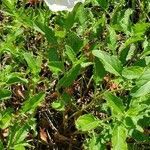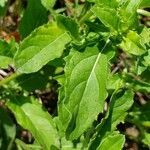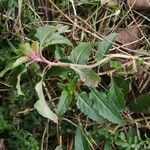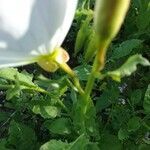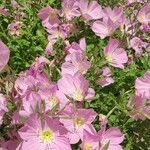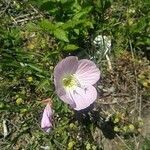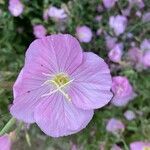Perennial herb from spreading rhizomes. Stems to c. 50 cm high, branched above ground, with a close, curved, antrorse pubescence. Basal leaves obovate to oblong-lanceolate, to 9 cm long, tapering towards base, usually deeply sinuately lobed below a large terminal lobe; cauline leaves variable, usually ovate-elliptic, c. 3 cm long, much reduced and bract-like on upper stem, sinuate to deeply lobed especially towards base. Inflorescence sharply nodding. Flowers in upper axils, opening in morning or evening. Hypanthium 1–2 cm long. Sepals 1.5–3 cm long, often failing to separate. Petals 2.5–4 cm long, white to rose-purple, usually pink in Australia. Capsule clavate, 10–15 mm long, strongly 8-ribbed on upper part, the base sterile and cylindrical, with close curved hairs; not seen mature in Australian material.
Perennial by creeping roots (sometimes annual?), ascending to erect, 1–6 dm; lvs linear to lanceolate or oblanceolate, 3–8 cm, gradually tapering to a petiolar base, entire to runcinate-pinnatifid, the basal half commonly more coarsely toothed than the upper; fls few, sessile in the upper axils, erect, buds nodding, long-acuminate; hypanthium slender, 1–2 cm, strigose; sep lance-linear, reflexed at anthesis, 1.5–2.5 cm, usually long connivent; pet obcordate, white or pink, 2–4 cm; stamens alternately unequal; fr narrowly obovoid or clavate, 10–18 mm, 4-sided, roundly 8-ribbed and deeply sulcate, tapering to both ends, sterile below; 2n=14. Dry, open places; Mo. and Kans. to Tex., and intr. eastward. May, June. (Hartmannia s.)
A herb. It keeps growing from year to year. It grows 50 cm tall. The stems can be hairy. The leaves are alternate and hairy. They are 10 cm long by 4 cm wide. The shape varies. The edges have teeth or are wavy. The flowers are cup shaped and have 4 petals. They are pink. They are in the axils of the upper leaves.
